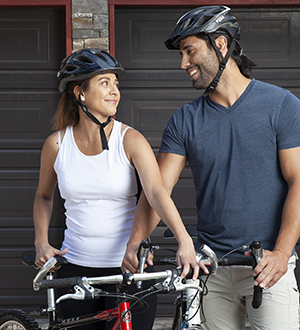Type 1 Diabetes: Getting Active
Activity can help you control your weight, get stronger, and feel healthy. It also helps lower your risk for heart disease. Being active doesn’t mean you have to exercise in a gym. Many everyday chores and tasks help you stay active.
What you need to be careful of when exercising when you have type 1 diabetes is the risk for low blood sugar (hypoglycemia). Your healthcare team can help you find ways to increase your activity and exercise safely.
Planning to get active
Talk to your healthcare provider before starting an activity program. You may need to have a checkup before you start.
Getting started
Your first goal is to increase your activity slowly. Try to find ways to include some activity in your daily routine. Here are some tips:
-
Do outdoor chores, such as yard work or gardening.
-
Take a 10-minute walk.
-
Walk up a flight of stairs instead of taking the elevator.
-
Park your car in the space farthest from where you’re going.
Changing the pace
When you’re ready, start increasing the pace of your routine. Choose any nonstop activity that makes your heart and lungs work harder than normal. These activities are called aerobic exercise. They include brisk walking, jogging, swimming, and bicycling.

Exercising safely
When you have diabetes, you have to balance your activity with food and insulin. A few easy steps can help you keep your blood sugar in your target ranges during activity.
Activity and blood sugar
Here are some tips to help manage your blood sugar when being active:
-
Deliver (inject) your insulin into areas of the body you won’t be using when you exercise.
-
Eat a snack before you exercise.
-
Ask your healthcare provider when you should check your blood sugar and which ranges make exercise unsafe. Also ask when you should check your urine for ketones
-
Carry snacks and fast-acting sugar, such as glucose tablets or fruit juice.
-
Check your blood sugar if you start feeling faint. If your blood sugar is low, follow the "15-15 rule." Take 15 grams of pure (fast-acting) sugar. That’s 4 to 5 glucose tablets or 4 ounces (1/2 cup) of fruit juice or sugar soda. Wait 15 minutes, then test your blood sugar again. If it hasn’t gone up, take another 15 grams of fast-acting sugar. If it’s still too low, call your healthcare provider or go to the emergency room. If your sugar is normal, eat a small meal.
-
Do resistance exercises before aerobic exercise. Resistance exercises include lifting weights and using exercise bands. This reduces your risk for hypoglycemia.
-
Do about the same amount of exercise at the same time each day. Exercising uses up calories from sugar. Following this exercise plan may help you balance your insulin doses with your blood sugar. It can prevent swings in blood sugar levels.
-
Get up and stretch at least every 30 minutes is you are sitting. Try to move around between your longer periods of exercise. This will prevent large swings in activity level.
Safety tips
Here are some tips to help you stay safe while being active:
-
Wear ID such as a bracelet or necklace that says you have type 1 diabetes in case of emergency.
-
Exercise with a partner.
-
Warm up before you exercise and cool down afterward. You can do this by walking and stretching. Your healthcare team can show you how.
-
Check your blood sugar level before you begin your exercise routine. You may need a carbohydrate snack before you even get started to prevent your blood sugar from getting too low. Discuss with your provider what level your blood sugar should be before aerobic activity. It's usually at a minimum 100 mg/dL.
-
Drink plenty of water.
-
Don't exercise when you are sick or if you have ketones in your blood or urine.